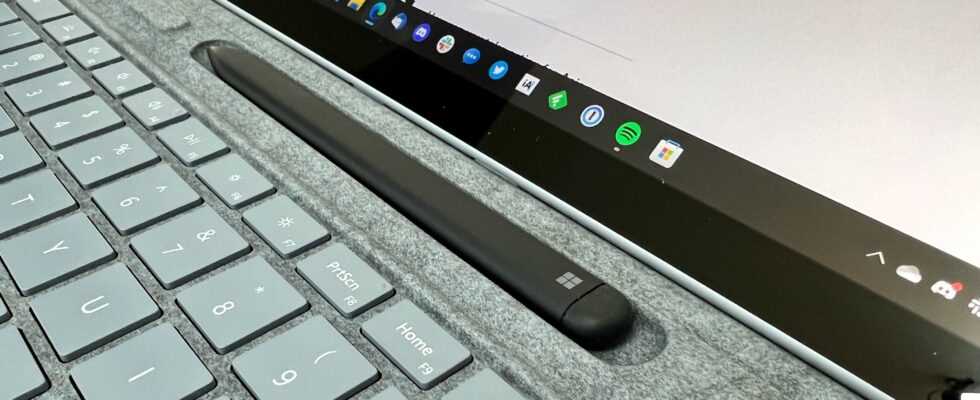Over the past few years here at ZDNet, I’ve written a lot on my iPad Pro. It’s my go-to work machine for writing, sorting through my inbox, and bouncing between Slack and Discord.

Microsoft Surface Pro 8 – Best prices:
 Rakuten
Rakuten979.89
 Fnac marketplace
Fnac marketplace1007.00
 Amazon Marketplace
Amazon Marketplace1110.94
 Amazon
Amazon1133.98
Shopping street
1179.00
 Baker
Baker1179.00
 Fnac
Fnac1179.99
 Darty
Darty1179.99
 LDLC
LDLC1199.95
But even though the iPad has been a staple in my workflow for the past decade, I’m getting tired of using overpowered hardware with software that doesn’t yet live up to its potential. Hopefully the announcement of iPadOS 16 next month will add, at a minimum, true external display support and better accessory support.
Over the past few months, I’ve tried different devices, mostly Windows laptops, in an effort to find something to replace my iPad Pro. The Surface Laptop Studio is fast, powerful and fun to use, but it lacks 4G technology and is bulky compared to the iPad Pro. I’ve used the iPad Pro intermittently since its release, and the form factor is great, but the lack of full support for Microsoft’s slow transition to ARM by third-party apps results in sluggish performance .
I then tested a Surface Pro 8 4G. In fact, this model is more specifically called Surface Pro 8 for business.
A new-look Surface… in a way
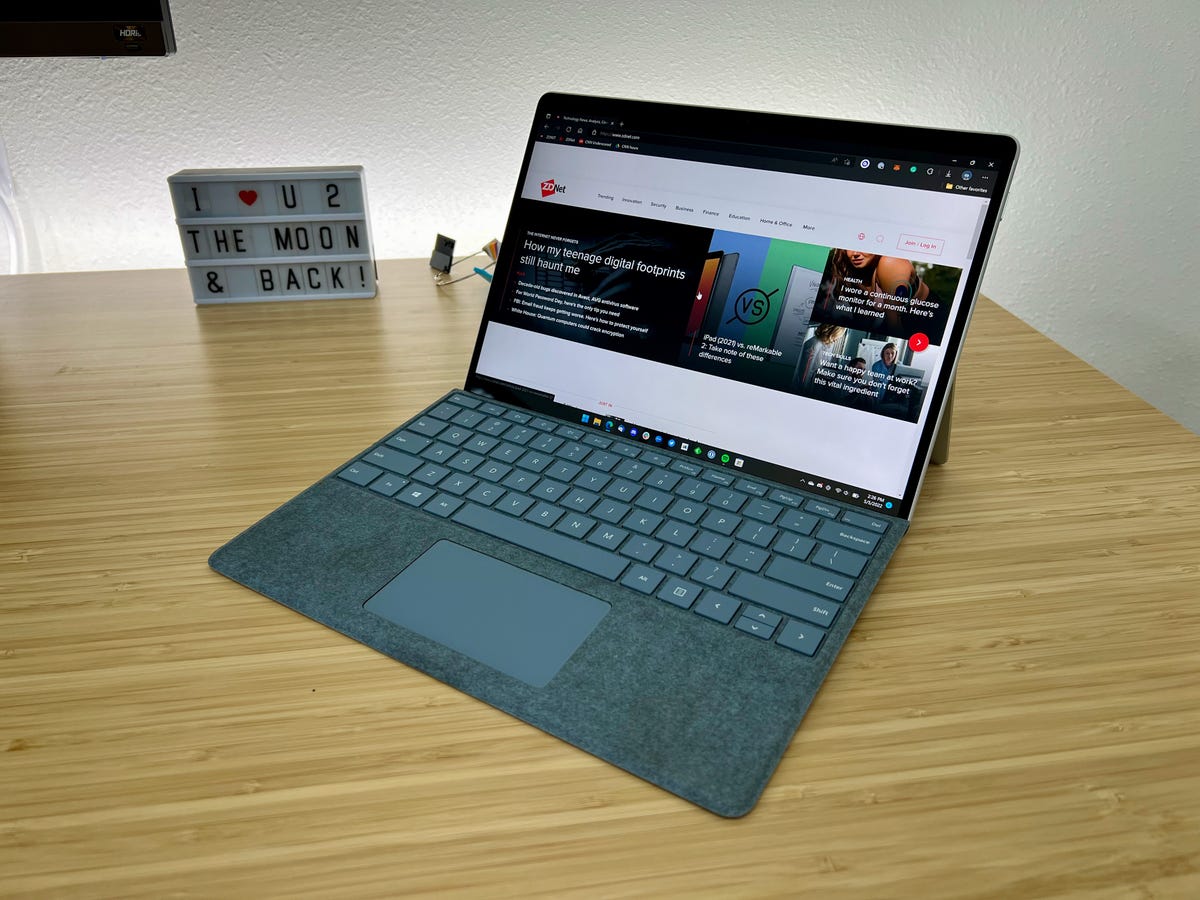
Jason Cipriani/ZDNet
When Microsoft announced the Surface Pro 8 in September 2021, the company showed off an all-new design for the Surface Pro line. In fact, this is not a new design, but the same general design as the Surface Pro X. Placing the Pro X next to the Pro 8, the only noticeable difference I can immediately see is that the Pro 8 is thicker than the Pro X. Otherwise, they are identical.
The Pro 8’s PixelSense display has a refresh rate of up to 120Hz, responds to touch, and can be used with a Surface Pen.
The built-in kickstand lets you change the viewing angle of the Pro 8 screen, including laying it almost flat on a table, an ideal position for drawing or writing with the Surface Pen.
On the right side of the Pro 8’s case is a Surface Connect port and two Thunderbolt 4 ports for connecting external displays, hard drives, or using any USB-C accessory. Just above the Pro 8’s only two ports is the power button. The left side of the case features a 3.5mm headphone jack and the volume up/down buttons.
Above the screen, you’ll find a 5-megapixel camera as well as all the hardware needed for facial recognition to use Windows Hello to unlock the Pro 8 or log into apps.
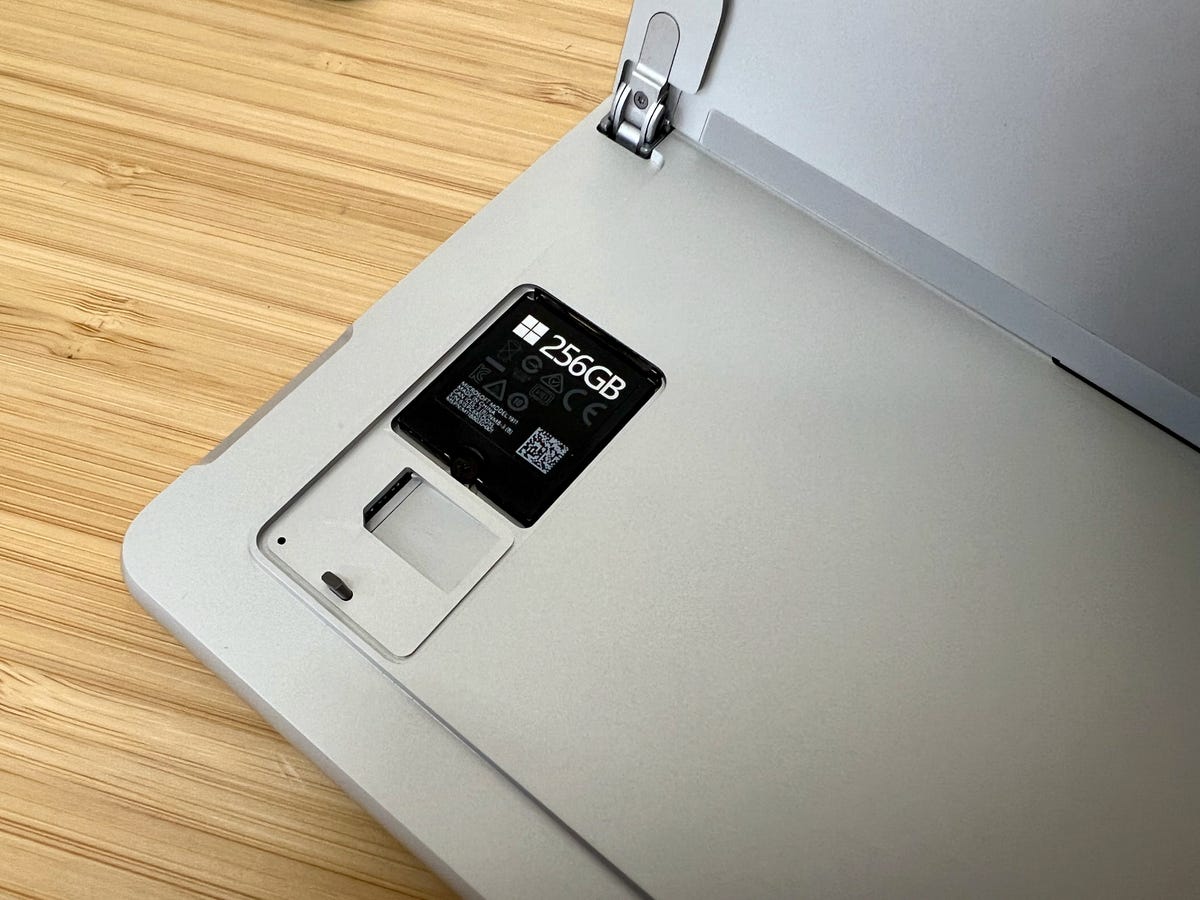
Jason Cipriani/ZDNet
When you open the kickstand, you’ll find a small door in the bottom left corner of the Pro 8 case. You’ll need to use a SIM card tool or a paper clip to press into the small hole to eject the cover. Under the lid is the Pro 8’s SSD storage – which you can swap out and replace yourself – as well as the SIM card slot.
You don’t need to use a physical SIM card thanks to the Pro 8’s eSIM support, but since I switch from Pro X to iPad Pro often, I already had a dedicated SIM card .
The box contains the Pro 8 and a charger that uses the Surface Connect port. If you don’t feel like carrying around the included charger, you can use one of the USB-C/Thunderbolt 4 ports to charge the tablet.
What you won’t find in the box is a stylus or a keyboard. Instead, you’ll have to buy them separately. If you’re a long-time Surface user, I have bad news for you: previous Surface keyboards won’t work on the Pro 8.
You have three different options for equipping your new tablet with a keyboard, turning it into a 2-in-1. You can choose the Surface Pro Signature Keyboard (177€), the Surface Pro Signature Keyboard with fingerprint reader (a little more expensive), or the Surface Pro Signature Keyboard combo with the Slim Pen 2 (230€).
I already had the combo kit, so that’s what I used during my testing.
Whichever keyboard you choose, they all have a Surface Slim Pen 2 slot above the keyboard. When folded, the stylus rests against the bottom bezel of the Pro 8. The stylus charges wirelessly, so it’s always ready to use.
Overall, I love the design of the Pro 8. In fact, I found myself using it as a tablet more than the iPad Pro, simply because the kickstand is built into the case. There isn’t another cover or case that I have to deal with. It’s fantastic.
But can it replace an iPad Pro?
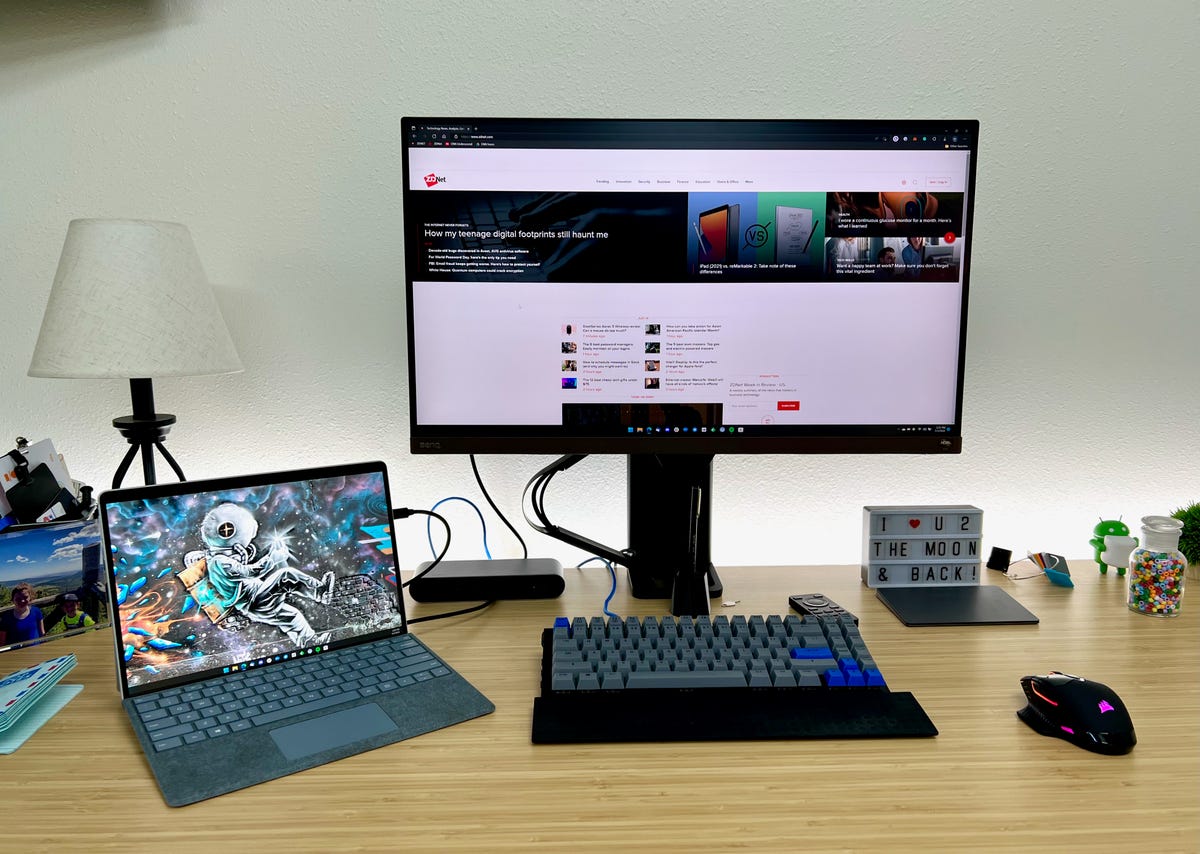
Jason Cipriani/ZDNet
Inside the Surface Pro 8 I tested is an 11th Gen Intel Core i7 processor, 16GB of memory, and a 256GB SSD. The computer was running Windows 11 Pro right out of the box. packaging.
One of the first things I did after setting up the Pro 8 was to enable the 120Hz refresh rate, instead of the standard 60Hz. Overall, I’m not sure it’s totally necessary on the Pro 8. Yes, it’s helpful, but it comes at the cost of battery life.
I haven’t reached the 14 hour battery life estimate yet, even using the Pro 8 only on Wi-Fi. However, the Pro 8’s battery lasted as long as my iPad Pro’s, which matches usually to an 8-hour workday, give or take an hour.
One thing that surprised me after using the Pro X and iPad Pro and upgrading to the Pro 8 is the fact that the Pro 8 still has a fan. The Pro 8 is much thicker than the Pro X to make room for a cooling system. The fan isn’t noisy, but it spins a lot, especially when I have the Pro 8 connected to an external display.
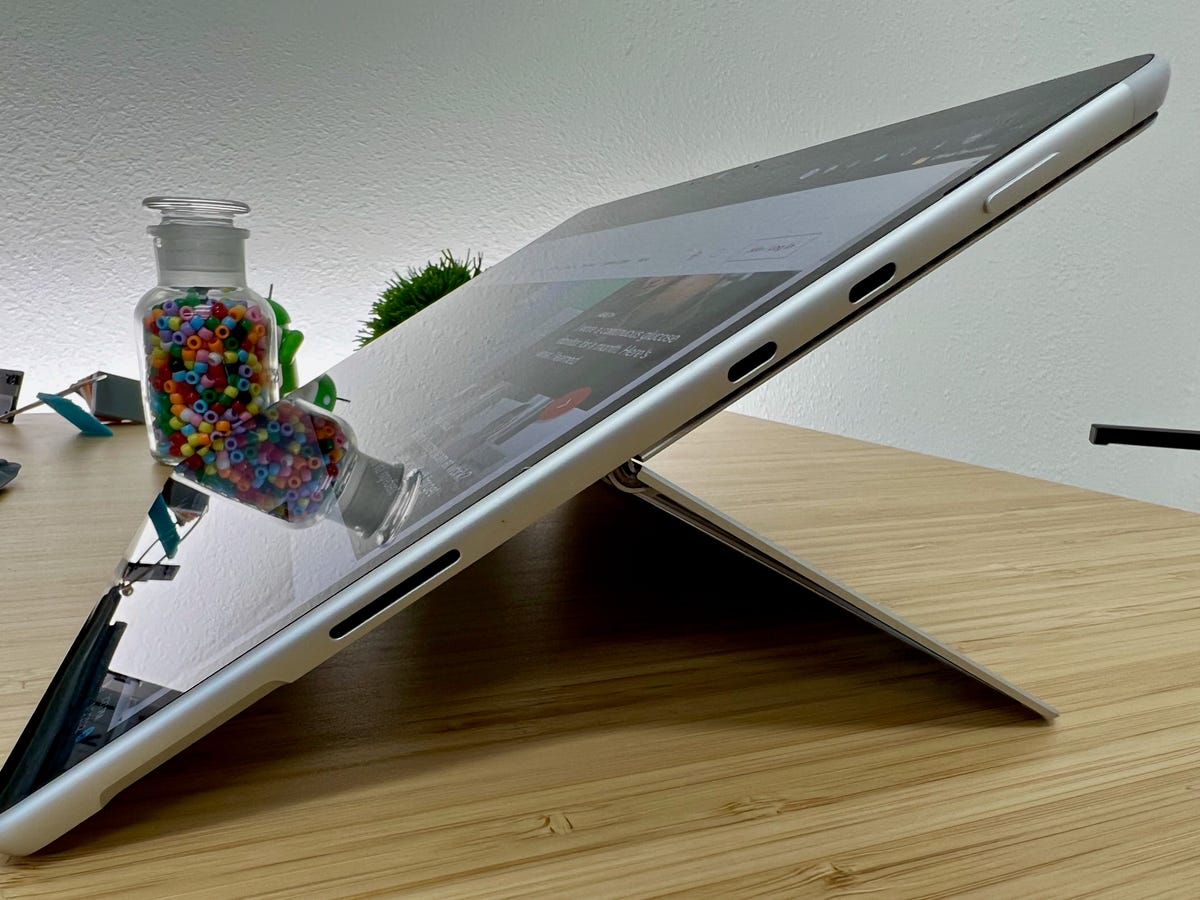
Jason Cipriani/ZDNet
Speaking of which, I had the Pro 8 hooked up to a monitor for the majority of my testing. With the addition of Thunderbolt 4 support, I was able to use every Thunderbolt 4 port I had on hand.
The ability to connect a tablet to an external display and have it work the way it’s supposed to is a huge boost to my productivity. I was able to have apps like Slack and iCloud messaging open on the Pro 8’s screen, while writing in iA Writer on the large external display with multiple Edge tabs open.
When I work on my iPad Pro connected to a display, everything on the iPad screen is mirrored on the big screen. There are a few apps that use Apple’s rudimentary API for external displays, but it’s not great.
Also, I have to resort to many workarounds to perform certain tasks on the iPad. For example, to post content to ZDNet, I often have to remotely access my MacBook Pro and use Chrome to add images to an article, otherwise the content management system crashes. To be fair, this is a Safari problem that also exists on the Mac. However, I can use the real version of Chrome on a Mac and not a version of the WebKit renderer that Apple forces developers to use on the iPhone and iPad.
I’m aware that the Pro 8 runs a full-fledged OS under Windows 11, while the iPad Pro runs a mobile-focused OS under iPadOS, but the devices are relatively the same size and aim for the same type of user. Even the prices are close enough to warrant the comparison.
The total cost of the Surface Pro 8 with 4G, as well as the Signature keyboard cover with Slim Pen, is around 2000 euros. The iPad Pro with 5G, 16 GB of memory, 1 TB of storage, the Magic Keyboard of Appeal with trackpad and an Apple Pencil costs more than 2500 euros.
There’s still a lot the iPad Pro does better
I’ll admit it, so far I’ve written what feels like a love letter to the Surface Pro 8, but that’s because it really deserves it. It’s a fantastic 2-in-1 device that I really enjoyed using, but there are some areas where the iPad Pro is simply a better device.
I prefer to use Apple’s Mail app with my personal iCloud+ domain rather than Thunderbird or the iCloud website to access my email. I also really like writing on the iPad because there are far fewer distractions with just one app open and visible. I need to experiment more with using fullscreen Windows apps and Focus assist to recreate a similar experience on Windows. It’s also a better tablet thanks to an interface designed for touch.
Another thing I like about my iPad Pro is that its performance is reliable and consistent. When I was using the Pro 8 with multiple apps open, there was sometimes a slight delay or pause before an app appeared after being minimized. This problem was not specific to a single application; I’ve come across it frequently with Thunderbird, Discord, and Slack.
In conclusion
After a few weeks of my iPad Pro sitting on a shelf, I started using it again as my primary device. But I already miss some features and things I could do on the Surface Pro 8 that I can’t on the iPad Pro – like plugging in a webcam to live stream an event over 4G (which I recently for my family members who could not attend a funeral).
So, iPad or Surface Pro 8? For me, it will depend on what iPadOS 16 brings to the iPad or not. But for everyone else, if you’re torn between the Surface Pro 8 and the iPad Pro, I’ll say this: you can’t go wrong with either device. They are both fantastic in their own right.
Ultimately, though, you get a full PC with the Surface Pro 8 and, currently, 80% of a PC with the iPad Pro.
Microsoft Surface Pro 8 – Best prices:
 Rakuten
Rakuten979.89
 Fnac marketplace
Fnac marketplace1007.00
 Amazon Marketplace
Amazon Marketplace1110.94
 Amazon
Amazon1133.98
Shopping street
1179.00
 Baker
Baker1179.00
 Fnac
Fnac1179.99
 Darty
Darty1179.99
 LDLC
LDLC1199.95
Source: “ZDNet.com”
